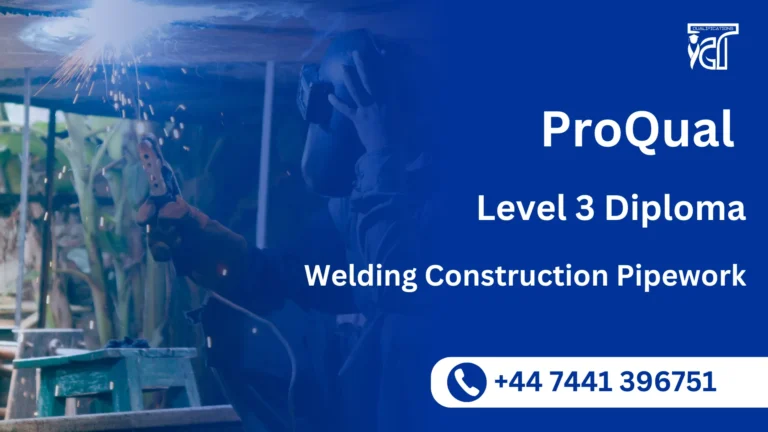The ProQual Level 2 NVQ Diploma in Construction and Civil Engineering Operations (Construction) – Laying Kerbs and Channels is a recognised, work-based qualification designed for individuals working in the construction and civil engineering industries who specialise in kerbing and channelling activities.
The ProQual Level 2 NVQ Diploma in Construction and Civil Engineering Operations (Construction)-Laying Kerbs and Channels provides learners with the opportunity to demonstrate and enhance their skills and knowledge in preparing surfaces, laying kerbs, channels, and edgings to required specifications, and ensuring compliance with health, safety, and environmental standards. It covers essential tasks such as setting out work areas, using tools and equipment properly, and reading technical drawings relevant to kerb and channel installation.
The course is assessed in the workplace, allowing candidates to gain certification through real-life tasks without the need for classroom-based exams. It is ideal for both new entrants under supervision and experienced operatives seeking formal recognition of their skills.
Successful completion of this qualification ProQual Level 2 NVQ Diploma in Construction and Civil Engineering Operations (Construction)-Laying Kerbs and Channels supports applications for the CSCS Blue Skilled Worker Card, enhancing job prospects and career progression within the construction and civil engineering sectors. Whether you are looking to improve your skills, gain a formal qualification, or advance your career, this NVQ provides a valuable pathway to professional development.
ProQual Level 2 NVQ Diploma in Construction and Civil Engineering Operations (Construction)-Laying Kerbs and Channels
The ProQual Level 2 NVQ Diploma in Construction and Civil Engineering Operations (Construction)-Laying Kerbs and Channels, to achieve the qualification candidates must complete all the mandatory units form the following
Mandatory Units
| Unit Title | Unit Level |
| Installing, maintaining and removing work area protection and safety equipment in the workplace Unit Endorsements: One of the following endorsements required: 1. Protection and safety notices 2. Safety lighting | 2 |
| Laying preformed kerbs and channels in the workplace | 2 |
| Preparing and operating powered units, tools or pedestrian plant, machinery or equipment in the workplace Unit Endorsements: One of the following endorsements required: 1. Generators 2. Pumps 3. Pedestrian operated plant or machines 4. Mixers 5. Compressors 6. Self-powered tools | 2 |
| Setting out secondary dimensional work control in the workplace Unit Endorsements: Three of the following endorsements required: 1. Lines 2. Levels 3. Depths 4. Areas 5. Heights 6. Angles | 2 |
| Conforming to general health, safety and welfare in the workplace | 1 |
| Conforming to productive working practices in the workplace | 2 |
GLH (Guided Learning Hours) and TQT (Total Qualification Time) are terms commonly used in vocational qualifications to help define the amount of time a learner is expected to spend on their studies.
1. GLH (Guided Learning Hours)
GLH refers to the number of hours a learner spends being directly taught, supervised, or supported during their course. This includes the time spent in activities such as:
- Classroom instruction
- Practical workshops
- One-on-one tutoring or mentoring sessions
- Online learning sessions with tutor support
In other words, GLH represents the time that learners are actively engaged with their instructors or learning activities.
2. TQT (Total Qualification Time)
TQT represents the total amount of time a learner is expected to invest in completing a qualification, including:
- GLH (Guided Learning Hours): Time spent on direct learning, as explained above.
- Self-Directed Learning: This includes time spent on independent study, research, assignment completion, preparation for exams, and any other work the learner does outside of direct teaching hours.
TQT is a broader measure that includes all the time required to achieve the qualification. It helps learners and employers understand the overall commitment required for the qualification.
Key Differences Between GLH and TQT:
- GLH focuses on direct learning with guidance or supervision.
- TQT includes GLH as well as independent study time and other learning-related activities.
Example:
If a qualification has a TQT of 600 hours and a GLH of 250 hours, it means the learner should spend 250 hours in direct learning (classroom, online, or tutor-led sessions) and 350 hours on independent study or research.
Upon successful completion of theProQual Level 2 NVQ Diploma in Construction and Civil Engineering Operations (Construction)-Laying Kerbs and Channels, participants will achieve the following learning outcomes:
Installing, maintaining and removing work area protection and safety equipment in the workplace
- Interpret the given information relating to the work and resources when installing, maintaining, and removing work area protection and safety equipment
- Know how to comply with relevant legislation and official guidance when installing, maintaining, and removing work area protection and safety equipment.
- Maintain safe and healthy working practices when installing, maintaining, and removing work area protection and safety equipment.
- Select the required quantity and quality of resources for the methods of work to install, maintain and remove work area protection and safety equipment.
- Minimise the risk of damage to the work and surrounding area when installing, maintaining, and removing work area protection and safety equipment.
- Complete the work within the allocated time when installing, maintaining, and removing work area protection and safety equipment.
- Comply with the given contract information to install, maintain, and remove work area protection and safety equipment to the required specification.
Laying preformed kerbs and channels in the workplace
- Interpret the given information relating to the work and resources when laying preformed kerbs and channels.
- Know how to comply with relevant legislation and official guidance when laying preformed kerbs and channels.
- Maintain safe and healthy working practices when laying preformed kerbs and channels.
- Select the required quantity and quality of resources for the methods of work to lay preformed kerbs and channels.
- Minimise the risk of damage to the work and surrounding area when laying preformed kerbs and channels.
- Complete the work within the allocated time when laying preformed kerbs and channels.
- Comply with the given contract information to lay preformed kerbs and channels to the required specification.
Preparing and operating powered units, tools or pedestrian plant, machinery or equipment in the workplace
- Interpret the given information relating to the preparation and use of powered units, tools or pedestrian plant, machinery or equipment.
- Know how to comply with relevant legislation and official guidance to prepare and use powered units, tools or pedestrian plant, machinery or equipment.
- Maintain safe and healthy working practices when preparing for and using powered units, tools or pedestrian plant, machinery or equipment.
- Select the required quantity and quality of resources to prepare for and sustain powered units, tools or pedestrian plant, machinery or equipment.
- Minimise the risk of damage to the work and surrounding area when preparing to and using powered units, tools or pedestrian plant, machinery or equipment.
- Complete the work within the allocated time when preparing to and using powered units, tools or pedestrian plant, machinery or equipment.
- Comply with the given contract information to operate powered units, tools or pedestrian plant, machinery or equipment to the required specification.
Setting out secondary dimensional work control in the workplace
- Interpret the given information relating to setting out dimensional control of the work.
- Know how to comply with relevant legislation and official guidance to set out dimensional control of the work.
- Maintain safe and healthy working practices when setting out dimensional control of the work.
- Select the required quantity and quality of resources to set out dimensional control of the work.
- Minimise the risk of damage to the work and surrounding area when setting out dimensional control of the work.
- Complete the work within the allocated time when setting out dimensional control of the work.
- Comply with the given contract information to set out dimensional control of the work to the required specification.
Conforming to general health, safety and welfare in the workplace
- Comply with all workplace health, safety and welfare legislation requirements.
- Recognise hazards associated with the workplace that have not been previously controlled and report them in accordance with organisational procedures.
- Comply with organisational policies and procedures to contribute to health, safety and welfare.
- Work responsibly to contribute to workplace health, safety and welfare whilst carrying out work in the relevant occupational area.
- Comply with and support all organisational security arrangements and approved procedures.
Conforming to productive working practices in the workplace
- Communicate with others to establish productive work practices.
- Follow organisational procedures to plan the sequence of work.
- Maintain relevant records in accordance with the organisational procedures
- Maintain good working relationships when conforming to productive working practices.
Benefits of the ProQual Level 2 NVQ Diploma in Construction and Civil Engineering Operations (Construction)-Laying Kerbs and Channels
1. Nationally Recognised Qualification
Achieve an industry-respected qualification that confirms your skills and competence in laying kerbs and channels, enhancing your credibility and value in the construction and civil engineering sectors.
2. Improved Career Opportunities
Boost your employability for roles involving groundworks, highways maintenance, and civil engineering projects. This qualification can also lead to progression into supervisory or specialised roles.
3. Work-Based Practical Assessment
Learn and get assessed in your real working environment, ensuring minimal disruption to your job while gaining a qualification that reflects real-world skills and practices.
4. CSCS Blue Skilled Worker Card Eligibility
Successful completion of this qualification helps meet the requirements for obtaining the CSCS Blue Skilled Worker Card, a key certification for access to most UK construction sites.
5. Enhanced Technical Skills
Develop essential skills such as preparing ground surfaces, setting out kerbs and channels, using tools and equipment safely, and interpreting technical drawings and specifications.
6. Greater Health, Safety, and Environmental Awareness
Gain a strong understanding of health and safety practices, environmental considerations, and site regulations specifically related to kerbing and channelling tasks, reducing the risk of workplace accidents.
7. Recognition of Existing Skills and Experience
For experienced workers, this qualification provides formal recognition of existing skills, offering an opportunity to certify expertise without extensive retraining.
8. Supports Career Development
Lays the groundwork for progression to higher-level NVQs, supervisory qualifications, or specialised certifications, contributing to long-term career growth within the construction industry.
9. Flexible Learning Approach
Assessment is tailored to individual work situations and learning needs, ensuring relevance to your specific job role and site activities.
10. Benefit for Employers
Employers gain a qualified, competent workforce that meets recognised industry standards, improving project quality, compliance, and overall site safety.
The ProQual Level 2 NVQ Diploma in Construction and Civil Engineering Operations (Construction) – Laying Kerbs and Channels is designed for individuals who meet the following profile:
1. Current Construction or Civil Engineering Operatives
Learners who are employed in the construction or civil engineering sectors and are actively involved in tasks such as laying kerbs, channels, and edgings as part of groundworks or highways maintenance projects.
2. Practicing Groundworkers and Kerb Layers
Those working as groundworkers, kerb layers, or general construction operatives whose duties include preparing ground surfaces, setting out work areas, and installing kerbs and channels to precise specifications.
3. Experienced Workers Seeking Formal Recognition
Operatives with practical, on-the-job experience in kerbing and channelling activities who wish to gain an industry-recognised qualification to formally certify their competence and skill level.
4. New Entrants Under Supervision
Individuals new to the construction industry who are working under supervision in kerbing and channelling roles and wish to develop the required skills and knowledge to meet industry standards.
5. Safety and Quality-Focused Professionals
Workers committed to carrying out their duties safely, efficiently, and to a high standard, in line with current health, safety, and environmental regulations.
6. Career-Oriented Individuals
Learners who are motivated to progress within the construction industry, with aspirations to gain higher-level qualifications or move into supervisory or specialist roles.
7. Responsible and Self-Motivated Workers
People who are able to work independently or as part of a team, taking responsibility for the quality and accuracy of their work and following technical drawings, plans, and site instructions.
Entry Requirements
To enrol in the ProQual Level 2 NVQ Diploma in Construction and Civil Engineering Operations (Construction) – Laying Kerbs and Channels, learners are generally expected to meet the following criteria:
Register Now
Qualification Process
Qualification Process for the ProQual Level 2 NVQ Diploma in Construction and Civil Engineering Operations (Construction)-Laying Kerbs and Channels
- Self-Assessment:
Begin by evaluating your eligibility to ensure you meet the qualification requirements, including work experience, knowledge, and language proficiency. - Registration:
Complete your registration by submitting the required documents, including a scanned copy of a valid ID, and paying the registration fee. - Induction:
An assessor will conduct an induction to confirm your eligibility for the course and explain the evidence requirements. If you do not meet the criteria, your registration will be canceled, and the fee will be refunded. - Assignmnets & Evidence Submission:
Provide all assignmnets and the necessary evidence based on the assessment criteria outlined in the course. If you are unsure of the required evidence, consult with the assessor for guidance on the type and nature of evidence needed. - Feedback and Revision:
The assessor will review your submitted evidence and provide feedback. Evidence that meets the criteria will be marked as “Criteria Met,” while any gaps will be identified. You will be asked to revise and resubmit if needed. - Competence Evidence:
Submit final evidence demonstrating that all learning outcomes have been met. This evidence will be marked as “Criteria Met” by the assessor once it is satisfactory. - Internal Quality Assurance (IQA):
The Internal Quality Assurance Verifier (IQA) will review your evidence to ensure consistency, quality, and compliance with standards. - External Verification:
The IQA will submit your portfolio to ProQual’s External Quality Assurance Verifiers (EQA) for final confirmation. The EQA may contact you directly to verify the authenticity of your evidence. - Certification:
Upon successful completion of all checks, ProQual will issue your official certificate, confirming that you have attained the ProQual Level 2 NVQ Diploma in Construction and Civil Engineering Operations (Construction)-Laying Kerbs and Channels.







